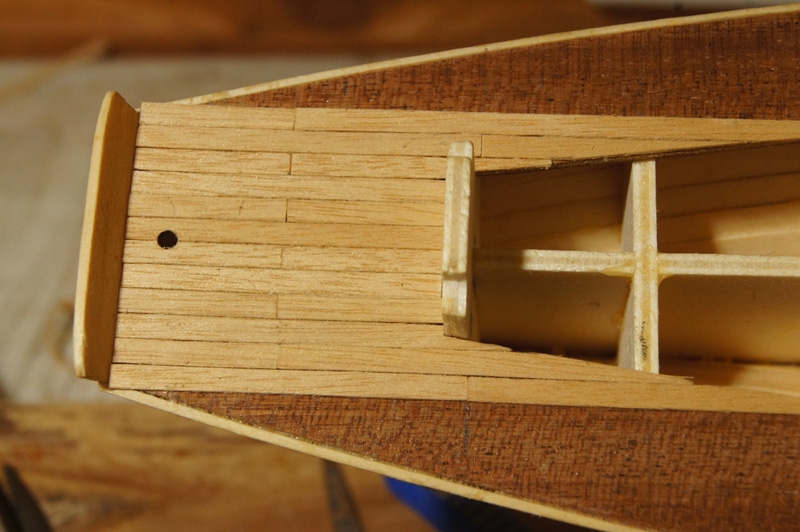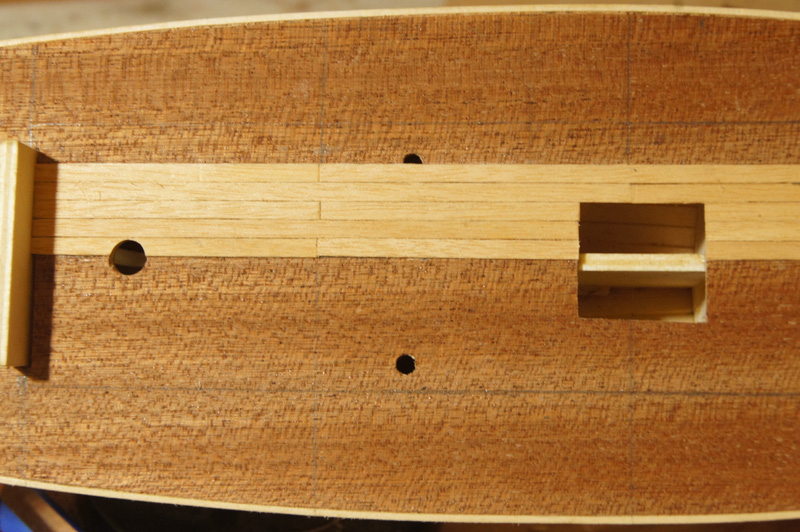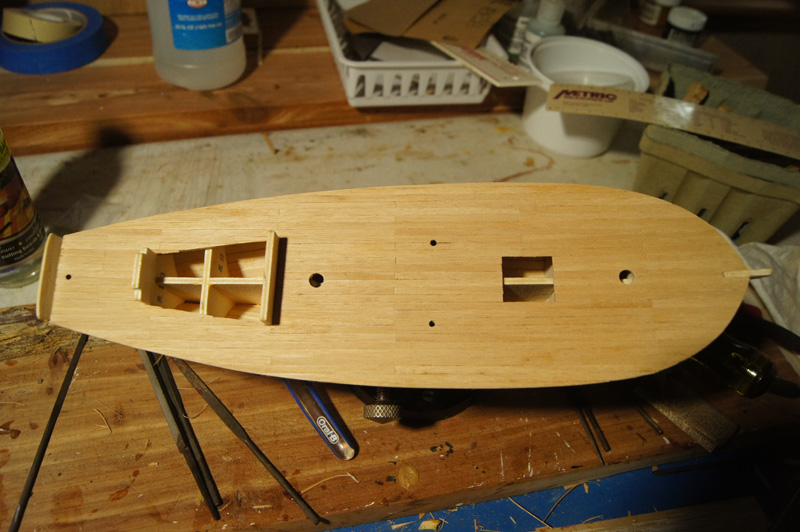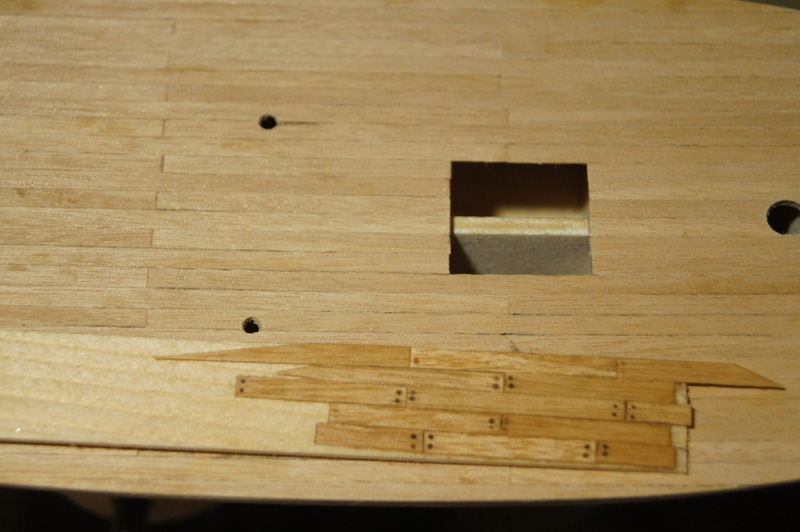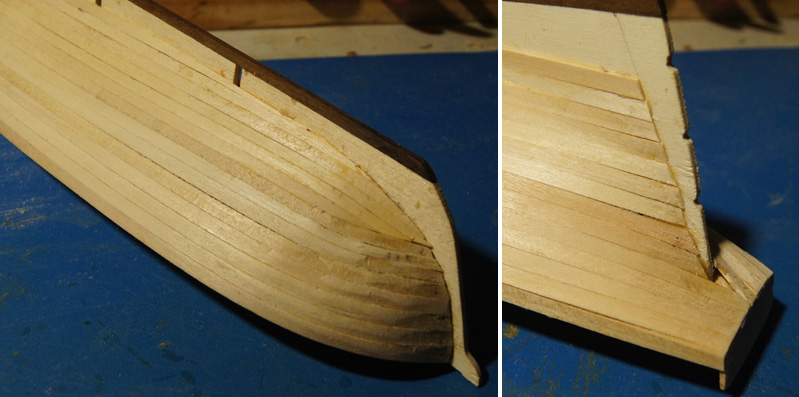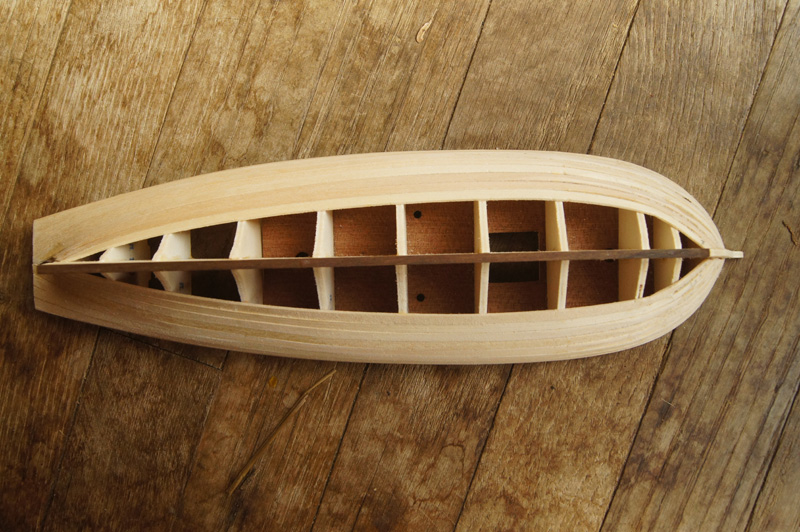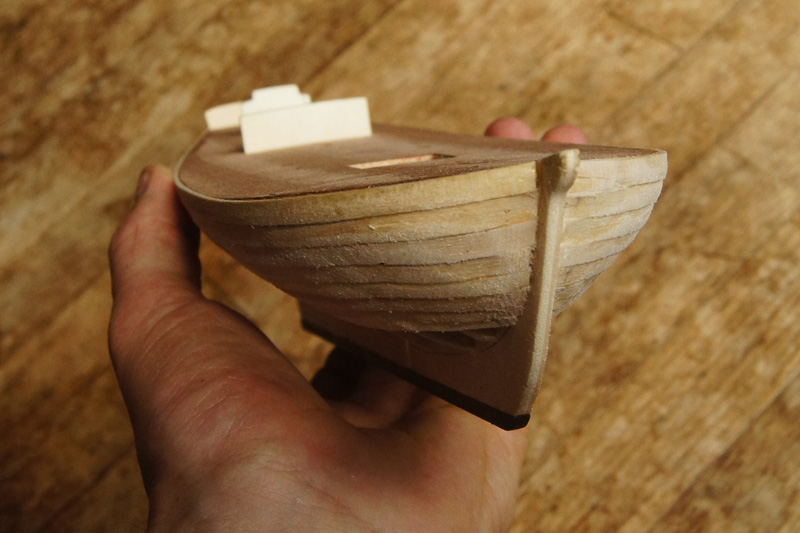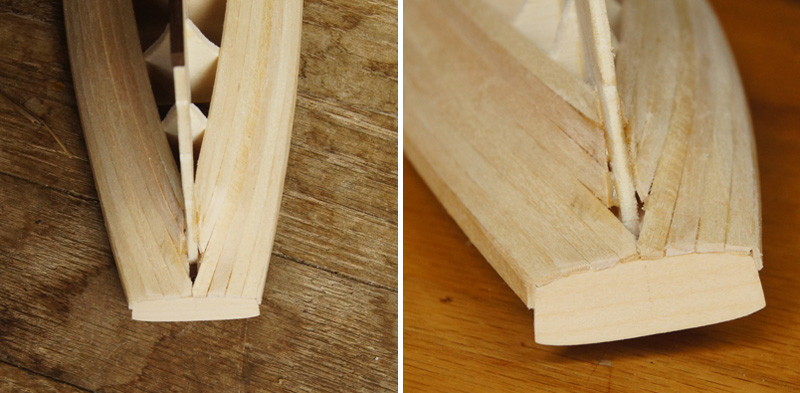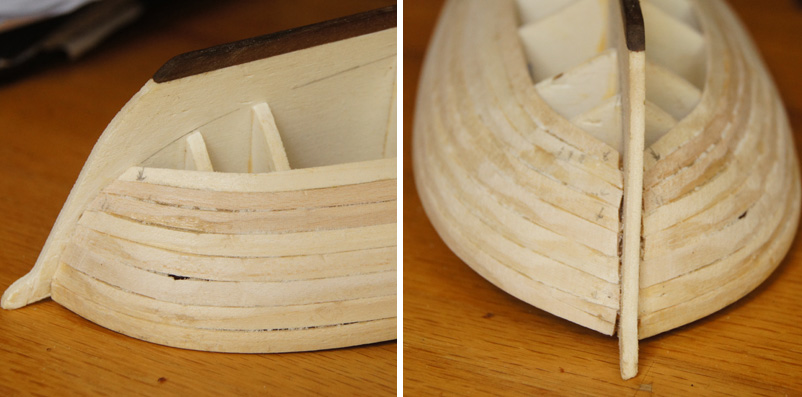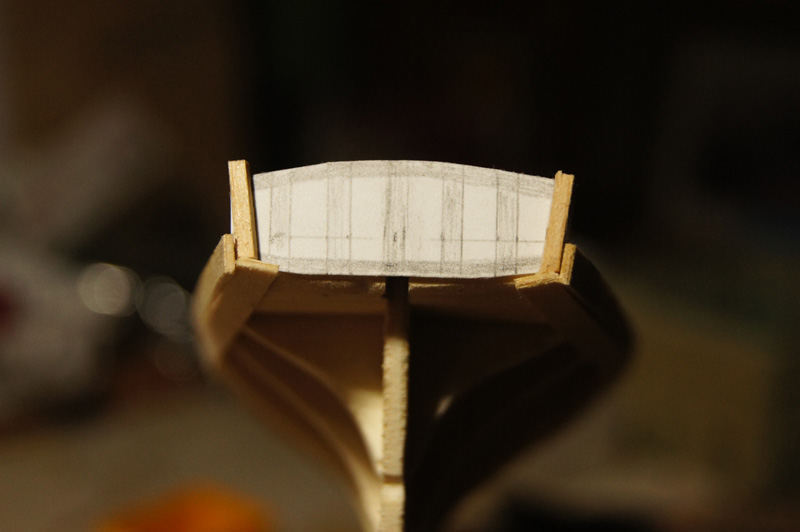-
Posts
3,529 -
Joined
-
Last visited
Content Type
Profiles
Forums
Gallery
Events
Everything posted by Cathead
-
druxey, there's a reason the vast majority of western river boats were built on the upper Ohio River: vast tracts of Appalachian forests right on the boatyards' doorstep. Not to mention the coal mines that fed the metal-working industry of Pittsburgh. Lovely work, Glenn. The longitudinal bunks are an interesting comparison to other boats.
-
Stage 5: planking the deck and bulwarks I'm not terribly impressed with the wood quality supplied for the decking. It's cut very roughly along the edges, necessitating a fair amount of sanding to get a smooth edge sometimes, which then makes it harder to arrange tight joints between deck planks. I began by drawing a square grid on the plywood deck, to help guide my planking. The plans show a fairly short plank length, which looked too busy to me and contradicted what I'd read elsewhere about planking normally running 20'-24' in this period. So I cut my planks to about 20' instead. I started at the stern along the centerline, and worked my way forward and out. You can see my grid in the second photo. Wherever I overlapped a hole (for masts or other purposes), I stopped when one plank crossed it, filed out that side of the hole, then kept going, filing the remainder when the next plank went in. This way I didn't have to drill anything and risk cracking the wood. Here's the finished deck before sanding. I think it came out nicely. Now I'm considering whether, and how, to simulate treenails (or the bolt and plug equivalent). The photo below shows one test, using thin holes filled with pencil, the seams gently lined with pencil, and the whole thing sanded and oiled. I'm trying to decide if it looks good, or out of scale and too busy. While researching treenail approaches, I ran across one mildly embarrassing thing. I'd followed the plans' approach to plank pattern, just alternating butt ends back and forth. Seems that a more prototypical way is a four-stage staggered layout, which is eminently sensible from an engineering point of view, but like a fool I just followed the plans again. So the deck may not be right to an expert, but at least it's visually pleasing (to me, anyway). Once I decide, I'll finish the deck, then construct the bulwarks. Only then do I go back to planking the second layer on the hull. Anyone have thoughts on the test approach to treenails?
- 96 replies
-
- topsail schooner
- revenue cutter
-
(and 3 more)
Tagged with:
-
Just now catching up on this build, and will add my amateur 2 cents that you're doing a wonderful thing, and a wonderful job. Thanks for being an inspiration.
- 2,191 replies
-
- confederacy
- Model Shipways
-
(and 1 more)
Tagged with:
-
The first planking is done; I simply filled in the remainder letting the planks run as they desired, not worrying about prototypical accuracy. It'll all be covered anyway. The photos below show it before any further sanding or filling, so it looks especially rough. Next, I sanded it down to a smoother finish, and rubbed the whole thing with wood glue. This filled in the gaps, and soaked into the planks, creating a much smoother, stronger shell that I then re-sanded. I consider the final result acceptable. It's still obvious that the planking pattern isn't right, but I now have a smooth shell in the hull's shape that should be a good surface for applying the second planking. I didn't take further photos because I don't think it'll look much different to the lens, and you'll see the finished surface again once I start the second planking. In the meantime, the next step is planking the deck, which is off to a good start. I'll post photos when the process is completed, it's pretty straightforward. Thanks for reading.
- 96 replies
-
- topsail schooner
- revenue cutter
-
(and 3 more)
Tagged with:
-
Looks very nice. I definitely like your choice of color scheme.
- 44 replies
-
- 18th century longboat
- model shipways
-
(and 1 more)
Tagged with:
-
Mike, I'm pretty sure the upper decks were covered in tarpaper or canvas, beneath which they were planked as usual. I think Kurt will have some suggestions for how to achieve that effect.
- 225 replies
-
- chaperon
- model shipways
-
(and 1 more)
Tagged with:
-

Steamboats and other rivercraft - general discussion
Cathead replied to Cathead's topic in Nautical/Naval History
Sal, that's a great insight! Seems very sensible. Don't know what to think about aesthetics, as it's so subjective. I do wonder whether they'd add a much larger box just for appearances, given how much weight and top-heaviness mattered to these boats.- 281 replies
-
- Steamboats
- riverboats
-
(and 3 more)
Tagged with:
-

Steamboats and other rivercraft - general discussion
Cathead replied to Cathead's topic in Nautical/Naval History
Pete, The core question here started with the rounded arch atop the paddlebox. I fully agree that a wider-than-minimum box makes sense at the level of the main deck, for everything from repair to debris to splash, but none of that explains the very wide arch at the next level up. Likely no one's crawling into that upper arch to do anything, why would they when you can just rotate the wheel 1/4 turn and work on it at the main deck level? But instead they still built the arch at the boiler deck level much larger than the wheel, which took more timber and added more weight, a significant choice given that these boats were very sensitive to both total weight and top-heaviness. Mark, I don't know for sure either. That's what makes it fun and maddening!- 281 replies
-
- Steamboats
- riverboats
-
(and 3 more)
Tagged with:
-

Steamboats and other rivercraft - general discussion
Cathead replied to Cathead's topic in Nautical/Naval History
Mark, it's my understanding that few western riverboats used variable-angle buckets on the wheel. Conditions were just too rough for them to work properly. Also, did these wheels turn fast enough to really splash water that high? These were geared for power, not rapid rotation, and I wouldn't think they'd spray water except near the surface. By the time the wheel had rotated toward the upper portion of the paddle box, the water was almost certainly mostly drained off the bucket. I could see allowing for extra space at deck level where the wheel first hits and emerges from water, but I'm trying to envision the need tens of feet up at the top of the arc, where this discussion is focused.- 281 replies
-
- Steamboats
- riverboats
-
(and 3 more)
Tagged with:
-
For context, nearly all of Bertrand's decking was preserved intact, and the archeology team mapped every plank. Most look to be 20-25 feet long, with a somewhat chaotic planking pattern that seems to fit the backwoods construction. Widths are pretty variable, too, again fitting the way a lot of early steamers were built. Given that Bertrand was built 30-odd years before Chaperon, I don't know how much decking methods changed in that time, I don't know much about these late steamers. I'd guess they were more standardized by the late 20th century. But that's at least some context for you. At scale, 20-25' comes out to roughly 13-16cm or 5-6 inches.
- 225 replies
-
- chaperon
- model shipways
-
(and 1 more)
Tagged with:
-
The photos are very helpful. It does like nice as it is. To my eye, it's too uniform and shiny, I find that subtle variations in color and finish make a model look far more realistic than a uniform finish, even if the latter is technically more accurate. So if you keep it, I'd try to dull and vary the finish a little bit, maybe with careful application of pastels or something. Make every few planks a slightly different shade, or more weathered, or something. But unlike a sailing ship, much of the deck will end up obscured, so maybe it doesn't matter. You could focus that effort only on the bow and other areas that will remain exposed. Those toothed joints between panels do stand out, but again most of that area will be covered, so I suspect that a few crates and barrels would take care of the rest. Does that deck have any plank ends? From the images, it looks like just a continuous run. It's probably too late to scribe in some plank joints, but that would give it some extra nice detail and variation as well, and is something that would happen naturally if you replank it. Honestly I'm torn. It would be a lot of work to replank what is a good-looking deck, and most of your work would be obscured (Chaperon has far more enclosed space than Bertrand did). I guess I'd say do it if you want the experience and the extra work and detail, but what you have would look plenty good with just a little finishing.
- 225 replies
-
- chaperon
- model shipways
-
(and 1 more)
Tagged with:
-
I posted this question over in Steamboats and other Rivercraft, so we don't fill up Glenn's log with too much speculation, partly to absolve myself from starting the speculation in the first place.I figured it's a general enough topic that the discussion and answer might fit well over there.
-

Steamboats and other rivercraft - general discussion
Cathead replied to Cathead's topic in Nautical/Naval History
Discussing the size of paddleboxes on sidewheelers? Recently in a build log, the question came up of why the paddleboxes on some sidewheelers are so much bigger than the wheels themselves. It's a very interesting question, which started to generate theories, so I thought I'd bring the topic over here so avoid cluttering the original log. Two suggestions mooted so far were: Anyone else have ideas or insight?- 281 replies
-
- Steamboats
- riverboats
-
(and 3 more)
Tagged with:
-
Here's an idea on the paddlebox: is the extra space to allow for the possibility of debris caught in the wheel? Most western rivers had a lot of woody debris (branches, logs, etc) and I could see a moderate-sized branch getting caught up between two buckets and being lifted up into the paddlebox, where it could do some damage to either the surrounding shell or the wheel itself once it gets wedged in there. Maybe the extra radius reduces the likelihood of this? Otherwise I'm quite interested to know what Kevin or other informed persons say.
-
Yes, Mike, I was talking about the toothed joints between deck panels, not the planking lines. Apologies for any confusion. What about setting small metal pins into the bottom of any post/tab that's supposed to fit into the deck, then just drilling tiny holes into the new deck for those pins to fit into? Could be hard to get the alignment just right, but probably no harder than actually fully redrilling so many holes then shaping them properly. Apologies if I'm overdoing the ideas; my mother has the same habit of constantly offering advice even when unwanted; I get the solving-others'-problem gene from her.
- 225 replies
-
- chaperon
- model shipways
-
(and 1 more)
Tagged with:
-
Mike, if you think only a few of those seams will show, you could always consider hiding them under a few loads of cargo (barrels, boxes, bales). That's a long-standing model railroad tradition for hiding oddities in work; many layout buildings with vines creeping up the walls look that way to hide a flaw in the paint or siding! If you decide to replank, those holes are a concern. Not knowing how the kit is set up, would it be easier to drill circular holes, then round the bottom of the posts or tabs that fit into them, rather than trying to square off lots of holes?
- 225 replies
-
- chaperon
- model shipways
-
(and 1 more)
Tagged with:
-
Stage 3 continued Welcome to "How not to plank a hull", by Cathead. I foolishly decided to follow the instructions' recommendations and diagrams for planking the hull, and have now concluded that that was a bad decision. Among other things, they tell you not to start tapering planks at the stem until the 6th strake, which is definitely not the right approach. In attempting to do so, I ended up doing quite a lot of extreme edge-bending and shaping, which produced some planks far too crinkled and buckled for my liking. I should have followed more normal guidance for hull planking from the start, with a lot more tapering right from the beginning. Luckily, this is only the first planking, and I've learned quite a bit about how planks will and won't lie on this hull form, giving me confidence I can do a much better job on the second planking. The first two photos show it in a moderately positive light, hiding some of the worst of the work. You can see the uneven run of the planks and some buckling, but once it's filled and finish-sanded I expect it'll provide a sufficient surface for the second layer. Sticking with the positive thinking, the stern has been less troublesome so far. I cut out a smaller transom support that fits the hull, imitating where the horn timbers would support the shape of the transom. I planked around the edge of it as various resources have appeared to suggest I should do. When the second layer goes on, and I plank both sides of this support, I'll extend it farther out in a curve to match contemporary images. I'm also thinking of adding an outside structure in the shape of the horn timbers, like you see in the image of USRC Louisiana I linked to above. I'm happy with the run of the planks here overall, but it did take some modification from the kit. The last few frames are too large, guiding the planking away from the stern, forcing a sharp bend inward to meet the end of the stern. I carved and sanded these last few frames down significantly to achieve a smoother run, and I probably could have done even more. You'll see that I still had trouble getting a couple planks to fully lie against the stern, they pulled away slightly despite pre-forming and sanding. But this is way better than if I hadn't cut down the frames. Again, I think filling and sanding here will produce a good surface for the final planking. And here's the embarrassing part. That's some ugly work right there. For too long I stuck to the original plans, telling myself that if I just kept going it would work itself out. It didn't. Given that this will be hidden forever, I've decided to change course and just fill in the remainder with planks cut to fit, rather than bent to fit. It will look ridiculous and inaccurate, but as it'll be hidden by the second layer, it'll make the work go faster and more happily. I've learned the lesson I needed to, and don't need to beat it in any further. For the second layer, I'll lay out proper planking belts and be more attentive to shaping and tapering planks. If I still don't do a good enough job, I'll consider coppering the hull (as shown on Louisiana), which will cover 90% of the surface anyway on this low-slung ship. So other builders be warned, don't be like me and try to force your way through bad instructions. Just plank the thing following the better guidance available elsewhere. I'll update again when the first layer is done. Thanks for reading, and controlling your laughter!
- 96 replies
-
- topsail schooner
- revenue cutter
-
(and 3 more)
Tagged with:
-
Mike, Looks great so far. I'm a bit late to the deck-painting discussion, but here's one other method I've used before. Use a cotton swab (Qtip) with diluted paint. Get the swab wet, press out the excess paint liquid against the side of a container, then use the swab to rub the color onto the wood. If you get it right, this allows a transfer of diluted color that's less sloppy than a brush, as you're essentially using the swab as a sponge, so it retains more moisture than a brush does. Certainly experiment on scrap first to get the hang of it, but I like it. I love the idea of replanking the deck, but it's not my model!
- 225 replies
-
- chaperon
- model shipways
-
(and 1 more)
Tagged with:
-
Idle? More like idol! Can't wait to see how you handle the chimneys, the geometry of fitting those through multiple decks is a challenge.
-
Roger, thanks. I think I have enough information to move ahead with something that will be better than the original, if not entirely prototypical. I'm going to try to mimic the Louisiana drawing above, in part. Hopefully I'll show some progress this weekend. I very much appreciate your willingness to advise amateur projects like mine.
- 96 replies
-
- topsail schooner
- revenue cutter
-
(and 3 more)
Tagged with:
-
My plans were slightly off, too. I didn't feel it made any difference in the construction of the model. Your comparison to Guillow's planes is a good question, as I've build those too, and in this context I don't think it's the same thing. The hull is pretty much a self-contained unit; there's no practical effect of each frame being in a slightly different spacing than the plans show. You could certainly try to get a new part from ME and see if it's different, but in my experience having just finished this kit, what you show won't make any difference to your build. Enjoy this kit, I'll be following along.
-
Roger, I'll look forward to your photo. After a bit more research, your explanation matches my new mental impression of how the transom is supposed to be; the filler blocks represent the lower/horizontal portion of the horn timbers, while the solid "transom" piece represents the upright framing that connects at an angle, just in a cheap and confusing way. The kit does have the stern extending out beyond the rudder post, which passes up between the filler blocks as it should, leaving the transom extending to the stern past the rudder, so I think that part is right (you can see this slot in the photo below). Here's a quick mockup of what I think the transom framing should look like. Just imagine the lower portion of this assembly mortising into the lower horn timbers extending away from the camera, into where the filler blocks are instead: This would then be planked over fore and after, I assume, with the aft planking extending in a gently rounded curve just a bit beyond the hull planking and the low bulwarks. I looked at a plan for a similar William Doughty vessel, and it showed a gently rounded transom extending just beyond the hull. The above is crude, and not glued into place or anything, just me test-fitting pieces and drawings to see if it feels right. What do you think?
- 96 replies
-
- topsail schooner
- revenue cutter
-
(and 3 more)
Tagged with:
About us
Modelshipworld - Advancing Ship Modeling through Research
SSL Secured
Your security is important for us so this Website is SSL-Secured
NRG Mailing Address
Nautical Research Guild
237 South Lincoln Street
Westmont IL, 60559-1917
Model Ship World ® and the MSW logo are Registered Trademarks, and belong to the Nautical Research Guild (United States Patent and Trademark Office: No. 6,929,264 & No. 6,929,274, registered Dec. 20, 2022)
Helpful Links
About the NRG
If you enjoy building ship models that are historically accurate as well as beautiful, then The Nautical Research Guild (NRG) is just right for you.
The Guild is a non-profit educational organization whose mission is to “Advance Ship Modeling Through Research”. We provide support to our members in their efforts to raise the quality of their model ships.
The Nautical Research Guild has published our world-renowned quarterly magazine, The Nautical Research Journal, since 1955. The pages of the Journal are full of articles by accomplished ship modelers who show you how they create those exquisite details on their models, and by maritime historians who show you the correct details to build. The Journal is available in both print and digital editions. Go to the NRG web site (www.thenrg.org) to download a complimentary digital copy of the Journal. The NRG also publishes plan sets, books and compilations of back issues of the Journal and the former Ships in Scale and Model Ship Builder magazines.



